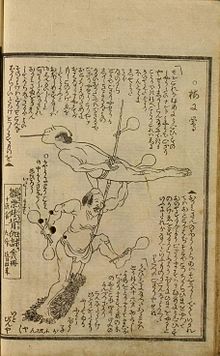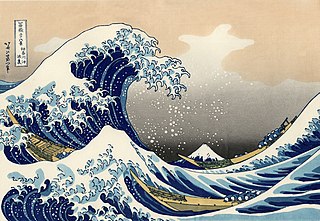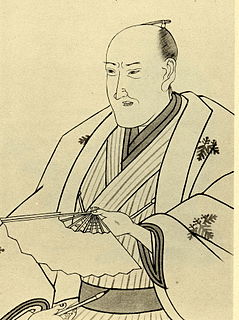
The kokkeibon(滑稽本, literally "comical book") was a genre and type of early modern Japanese novel. It came into being late in the Edo period during the 19th century. As a genre, it depicted the comical behavior occurring in daily life of the commoners.

Japan is an island country in East Asia. Located in the Pacific Ocean, it lies off the eastern coast of the Asian continent and stretches from the Sea of Okhotsk in the north to the East China Sea and the Philippine Sea in the south.

A novel is a relatively long work of narrative fiction, normally written in prose form, and which is typically published as a book.

The Edo period or Tokugawa period (徳川時代) is the period between 1603 and 1868 in the history of Japan, when Japanese society was under the rule of the Tokugawa shogunate and the country's 300 regional daimyō. The period was characterized by economic growth, strict social order, isolationist foreign policies, a stable population, "no more wars", and popular enjoyment of arts and culture. The shogunate was officially established in Edo on March 24, 1603, by Tokugawa Ieyasu. The period came to an end with the Meiji Restoration on May 3, 1868, after the fall of Edo.
The kokkeibon genre is the successor of the dangibon genre. Jippensha Ikku's Tōkaidōchū Hizakurige (1802–1822) is identified as the first representative novel. A less strict definition includes the dangibon as an "early kokkeibon".
The dangibon (談義本) was a pre-modern Japanese literary genre. Texts were written in a humorous, satirical sermon-style with the purpose of educating the masses. It is type of gesaku.

Jippensha Ikku was the pen name of Shigeta Sadakazu, a Japanese writer active during the late Edo period of Japan. He lived primarily in Edo in the service of samurai, but also spent some time in Osaka as a townsman. He was among the most prolific yellow-backed novel writers of the late Edo period — between 1795 and 1801 he wrote a minimum of twenty novels a year, and thereafter wrote sharebon (洒落本), kokkeibon (滑稽本) and over 360 illustrated stories,.

Tōkaidōchū Hizakurige (東海道中膝栗毛), abbreviated as Hizakurige and known in translation as Shank's Mare, is a comic picaresque novel (kokkeibon) written by Jippensha Ikku about the misadventures of two travelers on the Tōkaidō, the main road between Kyoto and Edo during the Edo period. The book was published in twelve parts between 1802 and 1822.
Kokkeibon generally consists of dialogue between the main characters and includes illustrations. The genre was most popular between 1804 and 1830 and is most representative by the works of Jippensha Ikku and Shikitei Sanba.

Kikuchi Hisanori, better known by his pen name Shikitei Sanba, was a Japanese comic writer of the Edo period.



